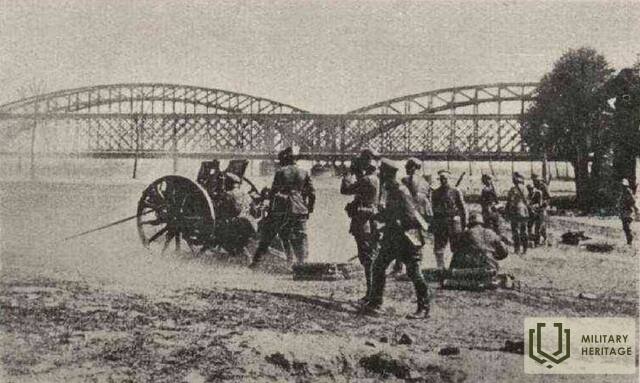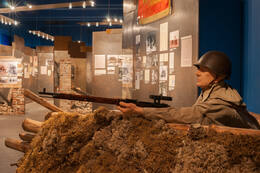Liberation of Riga from the Bolsheviks, 1919
I Wars of Independence

At the end of World War I, all of Latvia was controlled by the German 8th Army. Under these circumstances, on November 18, 1918, the independent Republic of Latvia was declared in Riga. A few days later, the Soviet Red Army invaded. Thus began a nearly two-year-long struggle, the Latvian War of Independence.
In December 1918, the Red Army of the Russian Bolsheviks entered the territory of Latvia. Although in words the Bolsheviks recognized the right of peoples to self-determination, in their actions they tried to preserve the indivisibility of Russian territory with the help of military force. Latvian rifle units also returned to Latvia as part of the Red Army. Separated from their homeland, they did not understand the transformations taking place in Latvia and thought that they would fight against the Germans. The Latvian Bolshevik government organized in Moscow, headed by Lenin's associate Peter Stučka, also came with the troops. The majority of the territory of Latvia came under the control of the Bolsheviks, except for the area around Liepāja.
On the evening of January 3, 1919, the first units of the Soviet Latvian Army entered Riga. As the Lielins approached Riga, German units of the Baltic Landeswehr joined the fighting. On March 3, 1919, anti-lielins forces launched an attack on the Courland front. Already on March 15, the Landeswehr captured Tukums and on March 18, Jelgava. The capture of Jelgava brought Soviet Latvia to the brink of collapse. The Lielins did everything possible to protect their power in Latvia. In order to replenish the army, they began a general mobilization, conscripting all able-bodied men remaining in Latvia.
In the early morning of May 22, 1919, the anti-Landeswehr forces went on the offensive on the Riga front. The resistance of the poorly supplied, trained and demoralized Soviet Latvian army regiments was quickly broken. The Latvian rifle regiments offered only symbolic resistance to the enemy and fled the battlefield. A large part of the riflemen surrendered or deserted from their units. Already in the early afternoon of the same day, the first Landeswehr units reached Riga.
Street fighting in Riga continued until the morning of May 22. Separate units of armed Bolsheviks, militias and small troops tried to delay the advance of the Landeswehr and Iron Divisions. Soviet institutions and their employees also left the city in great haste. Their escape was often accompanied by shots from the windows of houses. On May 23, the last Bolshevik units retreated behind Jugla. At the same time, the Separate Latvian Brigade commanded by Jānis Baložs, which had been delayed in battles with the Bolsheviks northwest of Riga, entered Riga.
After the battles of May 22, more than two hundred fallen Bolsheviks remained on the streets of Riga. In the following days, the city was subjected to repression by the victors against the Bolsheviks who had remained in the city and persons suspected of collaborating with them. The so-called “White Terror” began. Many innocent people suffered in these repressions and they had a pronounced ethnic character – almost all the victims were Latvians. The exact number of victims of the “White Terror” in Riga is unknown. Estimates range from 500-700 to as many as 5,000 people.
More information sources
1. Blizzard of Souls. Digital Museum. Available: https://www.dveseluputenis.lv/lv/laika-skala/notikums/111/pretlielinieciskie-speki-ienem-rigu/ [accessed: 08.05.2021.].
2. Ciganovs J. 1918-1920. Liberation Wars, 15.12.2010. Available: https://www.sargs.lv/lv/latvijas-neatkaribas-kars/2010-12-15/1918-1920-atbrivosanas-cinas [accessed: 08.05.2021.].
3. National Armed Forces website. Available: https://www.mil.lv/lv/latvijas-neatkaribas-kars [accessed 08.05.2021.].
Related timeline
Related objects
Latvian War Museum
The Latvian War Museum is located in the Old Town not far from the Freedom Monument in a historic defence building called the ‘Powder Tower’. There are 11 exhibits in the museum. There are various weapons, documents, uniforms, awards, badges and other items detailing the everyday life of a soldier in war. The Latvian War Museum is one of the oldest museums in Latvia. Its origins can be found in World War I. Museum’s collection was made up mainly of personal items of soldiers or items found on battlefields. After Latvia gained its independence the main goal of the museum became to create an exposition on the military history of Latvia and the active role of the population in protecting their land. In 1937 the museum was expanded and was technically one of the most modern museums in Europe at that time. The Powder Tower was one of the fortification towers of Riga. Some evidence dates back to 1330 where it has been mentioned as the ‘Sand Tower’. The tower was destroyed in 1621 when Riga was besieged by the Swedish Army. But in 1650 a new tower for storing gunpowder and weapons was built. After the city’s fortifications were taken down, the Powder Tower remains as one of the most important pieces of evidence of the Riga defence system.
Related stories
A commemorative badge dedicated to Admiral Makarov was found in the yard
A small military relic can tell a vast historical story. And although the badge represents events that took place during the Russo-Japanese War, it also shows the colorful military history and the involvement of our Latvian Riflemen in other military conflicts, both before and after the Wars of Independence.
Cape and the ship "Saratov"
It can be assumed that Liepaja was the capital of Latvia for a short period of time, because during the Freedom Struggle the Provisional Government was stationed on the ship Saratov in this very city. The Saratov took the Provisional Government to Riga after its liberation, but many people do not know that the history of such an important ship for us ended at sea at Akmenrags.
Aizporis Manor during the War of Independence
Aizporu Half Manor, Aizpute district, Kalvene municipality, is the westernmost place in Latvia to which Colonel Oskars Kalpaks' separate battalion retreated.
Halfway between Rudbārži and Kalvenė, on the side of the road, is the Aizpore cemetery. There is a monument and 12 memorials to the volunteer soldiers of Oskars Kalpaka's battalion.





